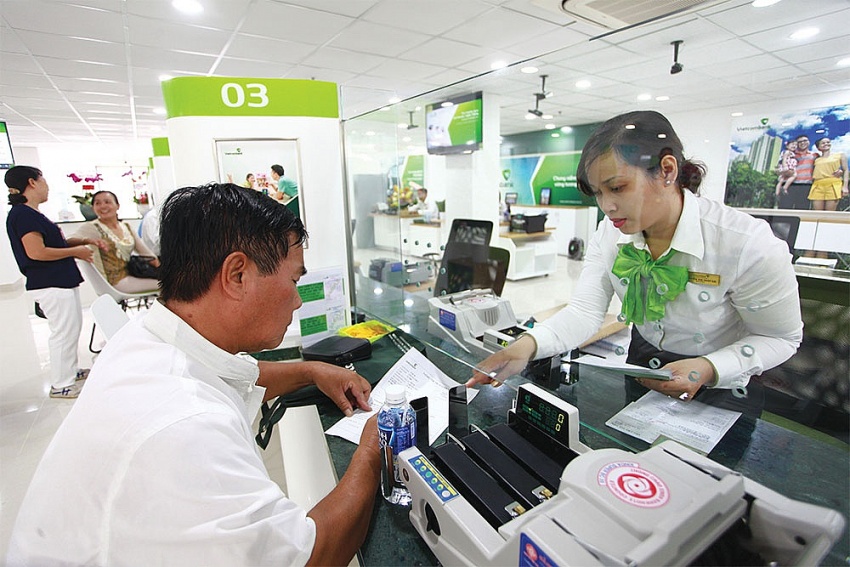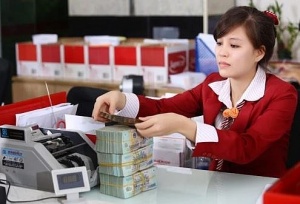Low lending rates may boost credit growth
According to June reports from Vietnam's four largest state-owned commercial banks, BIDV has the lowest average lending rate at 5.82 per cent per year, with a difference of 3.13 per cent between average lending and deposit rates. After accounting for costs related to capital mobilisation and utilisation, the net interest margin is 1.84 per cent per year.
Vietcombank's average lending rate is 5.9 per cent per year, with a spread of 3.2 per cent between average deposit and lending rates, and a net interest margin of 1.5 per cent per year after deducting related costs.
VietinBank's current average lending rate is 6.1 per cent per year, with an average interest spread of 2.4 per cent per year.
Agribank's average lending rate in June is currently 7.06 per cent per year. However, for short-term loans in certain priority sectors as directed by the government and the State Bank of Vietnam, the rate is only 4 per cent per year. The usual short-term lending rate is 5 per cent per year, medium and long-term loans are 5.5 per cent per year, and credit card loans are 13 per cent per year.
 |
For private banks, lending rates vary significantly. At Techcombank, the average lending rate for corporate clients was 5.92 per cent per year, with a spread of 2.67 per cent between average deposit and lending rates. For individual clients, the average lending rate was 7.03 per cent per year, with a spread of 3.78 per cent.
ACB's average lending rate for loans disbursed was 6.7 per cent per year, with a spread of 3.44 per cent between average deposit and lending rates.
Sacombank's average lending rate for loans disbursed was 7.53 per cent per year, down 0.1 per cent from the previous month, with a spread of 3.43 per cent.
At VIB, the average lending rate for individual clients is 6.81 per cent per year, and 5.8 per cent per year for corporate clients, with a spread of 2.96 per cent between average deposit and lending rates.
Lower lending rates are expected to stimulate borrowing demand from both individuals and businesses. A survey by VnBusiness of financial reports from the first quarter (Q1) of the year shows that banks with strong credit growth also have high outstanding loans in real estate.
For instance, MB's real estate business loans reached $1.886 billion by the end of Q1, up 4.6 per cent, by over $83.33 million from the end of last year. Meanwhile, the bank's total customer loan balance was $25.64 billion, an increase of only 0.7 per cent with over $175 million. Thus, nearly half of MB's credit growth comes from real estate.
VCBS's report forecasts that credit demand starts to accelerate from Q2 as low-interest rates stimulate borrowing and economic recovery. VCBS analysts predict annual credit growth for 2024 will reach 12-13 per cent.
This year's credit growth drivers include active production and export activities, increased public investment disbursements, especially in high-impact key projects such as in infrastructure. Furthermore, a clearer recovery in the real estate market from Q2 is expected to drive credit growth in the real estate, construction, and housing loan segments, contributing to overall credit growth for the year.
 | Banks post huge profits despite low credit growth Credit growth throughout the banking sector in the first quarter remained low at 0.26 per cent, but many banks still reported significant profits. |
 | Exchange rates set to put pressure on bank lending Exchange rate pressures will hinder the declining trend of interest rates in the near future, though when compared to other economies, the devaluation of the VND remains under control. |
 | Banks struggle to increase CASA ratio amid low credit growth The current account savings account (CASA) ratio witnessed a significant decline in the first three months of this year, prompting banks to almost unanimously adopt technology policies and 'zero fee' initiatives to attract new customers. |
What the stars mean:
★ Poor ★ ★ Promising ★★★ Good ★★★★ Very good ★★★★★ Exceptional
Related Contents
Latest News
More News
- Gold market reform advances as SBV receives applications for bullion production (December 30, 2025 | 12:07)
- EVN and AFD sign credit agreement for Vietnam’s first pumped storage hydropower plant (December 30, 2025 | 10:06)
- Techcombank Priority Visa Signature unlocks a higher standard of living (December 29, 2025 | 16:44)
- Tax sector wraps up 2025 and sets priorities for next year (December 25, 2025 | 14:00)
- A tipping point for digital and hybrid wealth management in Vietnam (December 23, 2025 | 13:33)
- $250 million deal targets women-owned SMEs, sustainable agriculture (December 22, 2025 | 17:40)
- Stock market posts resilient 2025 performance (December 19, 2025 | 18:17)
- Citi Vietnam receives 2025 AmCham CSR recognition (December 19, 2025 | 16:35)
- As global green supply chain reshapes, will Vietnam be left behind? (December 19, 2025 | 08:00)
- Banks gear up for massive capital increases (December 18, 2025 | 17:04)

 Tag:
Tag:





















 Mobile Version
Mobile Version